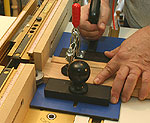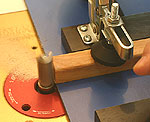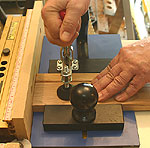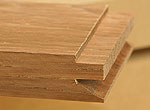This is a Veteran Owned site
![]()
Rockler Rail Coping Jig
Made right, works right, priced right
Text, photos & video by Tom Hintz
Coping the ends of rails is a critical part of door making. It is also an easy place to make a mess of things if the stock is not held flat and square to the bit during the cut. Because we are cutting directly across the grain, blowout at the trailing edge of the cut is a very real problem.
I enjoy making my own jigs as much as anyone, but trying to design a coping jig that works is a difficult task, especially when the cost of the pieces and labor are compared to the Rockler jig reviewed here. When I saw the Rockler Rail Coping Jig (#28595) and its price, I gave up on the idea of building my own.
Assembly
The Rockler Rail Coping Jig needs a little simple assembly as it comes from the box. Just putting it together reveals more reasons buying is better than building. The handles have metal threaded inserts molded in that make them far more durable than simple screws into wooden grips. All of the screw holes are accurately pre-drilled and counterbored where necessary. This level of factory preparation reduces assembly time to about three-minutes.
The 13 ½”-long by 7 ¾”-wide baseplate is made from a composite material that insures it will remain perfectly flat despite exposure to humidity changes in the shop. The composite core is covered with a slick laminate that slides easily on the table surface. That lets the operator concentrate on what is happening at the bit rather than overcoming resistance or catches generated by the plate on the table surface.
 |
Between the large, no-mar foot on the post clamp and an abrasive strip along the edge of the clamping block, the stock is held very securely. Click image to enlarge |
The main fence block and sacrificial (replaceable) strip come pre-mounted. Their alignment is critical and after checking, was found to be perfectly square to the edge of the plate. The sacrificial strip is mounted with screws, making it easy to replace when it becomes damaged or the bit profile is changed.
Because the Rockler Rail Coping Jig slides along the fence rather than in the miter track, there is no further adjustment required until the stock is actually clamped in place. This design also makes the Rockler Rail Coping Jig compatible with any router table that has a fence.
In The Shop
The only problem encountered with the Rockler Rail Coping Jig was discovering that the end of the sacrificial block hung slightly over the edge of the baseplate. Since this side goes against the fence, I was concerned that it might cause the jig to pivot horizontally during the first cut. With a bottom-bearing flush trim bit installed in the router table, I made one pass and shaved what looked to be less than 1/64 th from the end of the sacrificial block and that potential problem was eliminated.
The simplicity of the Rockler Rail Coping Jig makes setup and use a snap. With the jig against the fence, hold the stock to the sacrificial strip, its end against the face of the fence. Move the forward clamping block against the stock and tighten the locking knob. Flip the post clamp lever to lock the stock down and the Rockler Rail Coping Jig is ready for use.
Between the abrasive strip on the forward clamping block and the large, no-mar pad on the heavy-duty post clamp, the stock is held very securely. As long as the Rockler Rail Coping Jig is held against the fence, the cut will be square and consistent.
The easiest mistake to make when using this type of jig is not setting the bit height with the stock (or setup block) on the base plate. At only 5/16”-thick, there remains plenty of height adjustment to properly align the bit with the stock.
Making coping cuts is far easier with the Rockler Rail Coping Jig than with any other device I have tried. The stock remains perfectly aligned with the bit and the holding power of the clamping systems lets me concentrate on feeding the stock across the bit properly to get the best cut.
Video Tour! |
Also, flipping the stock around to make the cope on the other end takes seconds with the same level of security and accuracy guaranteed. Because the Rockler Rail Coping Jig holds the stock so well, and indexes it precisely for each cut, making multiple doors is fast and very consistent.
The large handles make controlling the Rockler Rail Coping Jig effortless and very safe. You have full control throughout the coping process without fingers passing close to the spinning bit.
Conclusions
With a price of $49.99 (6-20-2006) the Rockler Rail Coping Jig is one of the more economical must-have tools if rail and stile joints are part of your woodworking. The safety and consistency this jig brings to this task is worth far more than the investment. The convenience of a jig that works so well right out of the box is a rarity these days, at any price.
The only thing that ticks me off about having the Rockler Rail Coping Jig in the shop is the amount of time and money (I don’t want to add up how much) I wasted on trying to home-engineer jigs that never worked as well. Once again, buying the right tool for the job would have saved money, time and the frustration of trying to make good joints without it. Lesson learned – again.
Do you have a comment on this review? - Email Me!
All written, photographic and drawn materials are property of and copyright by NewWoodworker.com LLC 2000-2019. Materials may not be used in any way without the written permission of the owner.







